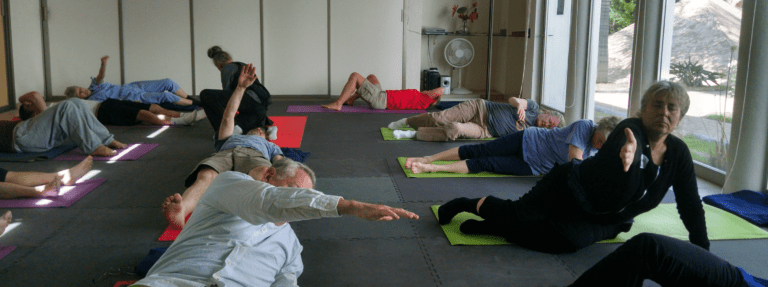When Body and Mind Collide: Exploring Depression as a Movement Disorder
In the realm of depression research, exercise has long been hailed as a potential remedy. But let’s face it—advocating for exercise as a one-size-fits-all solution to alleviate depression is a rather simplistic approach. While we have all likely experienced feeling better after getting out for a walk in nature or a good workout, that movement as a major cause for depression seems unlikely.
Thanks to a groundbreaking study in 2022 a more nuanced understanding of depression and its intricate connection with movement has emerged. These findings illuminate the path towards a more targeted and effective approach to depression treatment, and for how we perceive and utilize movement as a therapeutic tool.
In this blog post, we will dive deep into the profound connection between depression and movement, and explore how the Feldenkrais Method, along with other movement-based therapies, can be invaluable tools in alleviating its effects and promoting overall well-being.
Table of Contents

Understanding Movement Challenges in Depression
Many folks tend to think of depression as something that mainly impacts our thoughts and emotions. It is often described as a state of enduring sadness and a noticeable lack of enthusiasm or pleasure in activities we used to enjoy. However, recent research suggests that depression doesn’t limit itself to affecting emotions and thoughts but also influences the body’s physical functions.
Studies indicate that depression may be more than a mood disorder; it could also be considered a movement disorder, affecting not only our mental health but also our body movements.
Recognizing these movement issues is crucial for developing a holistic approach to depression treatment.
- Key Takeaway: Movement issues in depression go beyond mere physical symptoms. They encompass a wide range of motor function impairments.
Muscle Tone and Posture: Important Clues
Muscle tone and posture play a pivotal role in revealing the underlying movement issues in individuals with depression. These key indicators can provide valuable insights into the motor function deficits experienced by those experiencing emotional challenges.
- Commonly observed in individuals with depression is a tendency toward low muscle tone, known as hypotonia.
- Hypotonia involves reduced muscle tension and strength, potentially leading to posture and balance issues.
Assessing Motor Skills in Individuals with Depression
A traditional approach would emphasize the assessment of gross motor skills in identifying and understanding the movement impairments seen in individuals with depression. This evaluation can provide valuable data to guide the development of targeted movement interventions.
- Gross motor skills encompass movements involving larger muscle groups.
- These include activities like walking, running, and jumping.
- Individuals experiencing depression may demonstrate reduced coordination, less gross body movement and impaired balance during these activities.
A Somatic Education Approach Includes Perceptual-Motor Skills: Implications for Individuals with Depression
Understanding the significance of perceptual-motor skills in individuals with depression is crucial for fully grasping the extent of their movement challenges. These skills, which involve the interpretation of sensory information and the execution of motor responses in a way that feels good to the person, can be profoundly affected by depression.
- The client may experience difficulties in coordinating their movements based on sensory input.
- As a result, they may have difficulty performing motor tasks accurately and effectively, keeping their balance, and synchronizing their movements, which are necessary for tasks like walking, climbing stairs, and getting up from the floor or a chair without stumbling or falling.
- In general, they may not find pleasure in their body or have a self-image which contributes to or perpetuates the depressed state.
A Closer Look at Movement: Research Discoveries
Extensive research has unveiled a profound link between movement and depression. The findings provide valuable insights into the underlying mechanisms and highlight the importance of addressing movement issues in depression treatment.
- Key Takeaway: Research has revealed that individuals with depression exhibit distinct movement patterns compared to healthy controls. These patterns often involve slower and more rigid movements.
Psychomotor Tasks: Insights into the Connection
Psychomotor tasks have proven to be a valuable tool in illuminating the link between movement issues and depression. By assessing various psychomotor skills, researchers have gained a deeper understanding of how depression affects motor function.
- Psychomotor tasks assess the integration of cognitive and motor skills.
- They involve activities such as walking forward/backward in a straight line, walking on heels, jumping, finger tapping, timed reaction tests, and hand-eye coordination exercises.
- Individuals struggling with depression may demonstrate impaired performance and decreased speed in these tasks.
Exploring Subdomains of Movement
To fully grasp the impact of depression on movement, it is necessary to explore the subdomains of movement affected. These subdomains provide a detailed understanding of the specific motor deficits experienced by depressed individuals.
- Subdomains of movement include muscle tone and posture, gross motor skills, Body image/ organization and perceptual-motor skills.
- Individuals with depression may exhibit abnormalities in one or more of these subdomains. For instance, they may present with reduced muscle tone, compromised posture, impaired coordination, and difficulties with balance.
Significance of Research: Identifying Key Differences
Muscle Tone, Posture, and Gross Motor Skills: Individuals with Depression vs. Healthy Control Group
A comparative analysis of muscle tone, posture, and gross motor skills between depressed individuals and healthy controls reveals notable differences. These differences shed light on the specific movement impairments that contribute to the overall motor dysfunction in depression.
- Individuals with depression commonly exhibit lower muscle tone and difficulties in maintaining proper posture compared to healthy controls.
- These factors can lead to decreased coordination and balance during gross motor activities.
Unseen Tension: The Hidden Aspect of Depression
While the physical manifestations of movement issues in depression are evident, there is also an unobservable aspect to consider. Unobservable tension, originating from psychological distress, can significantly impact an individual’s movement abilities without being immediately apparent.
- Unobservable tension refers to the internalized stress and emotional burden experienced by individuals with depression.
- This tension can lead to increased muscle stiffness and reduced flexibility, affecting overall movement quality.
Integrating Body and Mind: Implications for Treating Depression
When we actively tackle issues related to movement and work on harmonizing our body and mind, it can truly work wonders in how we manage depression and our overall state of health.
-
Key Takeaway:
Integrative approaches that emphasize the interplay between body and mind can lead to positive outcomes in depression treatment. Techniques like the Feldenkrais Method focus on enhancing body awareness and facilitating improved movement patterns.
Movement and the Feldenkrais Method: A Transformative Approach
The Feldenkrais Method presents a transformative approach to addressing movement issues in depression. This method emphasizes mindful movement and awareness, allowing individuals to develop a healthier, more helpful self-image. This comes from increased awareness of how they move and the spontaneous discovery of more efficient and pleasant movement patterns.
Efficient movement leads to less energy expenditure. And the realization that one can learn and grow and do more than expected provides an upgrade in how a person embodied experiences and views themself.
- Through increased body awareness and enhanced motor function, individuals can experience a reduction in depressive symptoms.
- Its holistic approach aims to improve movement and function by reorganizing the way the brain and body interact. The method has been used to treat a range of movement disorders, including Parkinson’s disease, dystonia, and spasticity.
The Healing Power of Movement
Many individuals have found comfort and release from old habits of thinking through the Feldenkrais Method, discovering that it doesn’t just alleviate physical symptoms but also helps combat the emotional grip of depression. It provides them with tools to navigate daily challenges, promoting resilience and overall well-being.
Expanding the Horizons: Yoga Therapy, Somatic Methods, and Mind-Body Practices
In addition to the Feldenkrais Method, other movement-based therapies like yoga and tai chi are mind-body practices that offer promising avenues for managing movement issues in depression. These integrative methods acknowledge the interrelatedness of the body, mind, and emotions. They offer comprehensive assistance to improve our physical motor function and overall wellness during therapy sessions.
When we acknowledge and grasp the link between depression and movement challenges, interventions like the Feldenkrais Method and other mind-body practices open up exciting opportunities. They have the potential to enhance our physical abilities, relieve the burden of depressive symptoms, and elevate our overall well-being.
Embracing a holistic approach that blends body and mind can truly bring about transformative outcomes in the journey to overcome depression.
Wrapping Up: Movement as Medicine
In redefining depression as not just a mental but also a movement disorder, we expand our arsenal of treatment modalities. Embracing the body’s innate ability to heal through movement can be our most potent weapon against the multifaceted challenges of depression. When the mind feels trapped, perhaps it’s time to let the body lead the way to healing.
